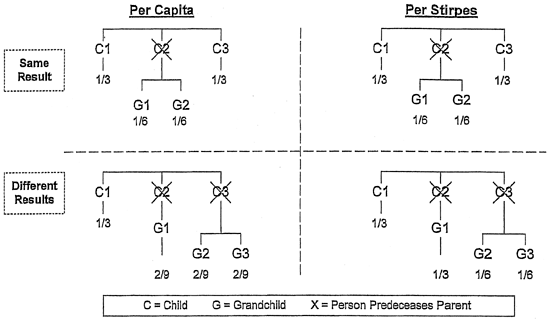Trusts and Wills often make reference to the Latin legal phrases “per capita” or “per stirpes” (pronounced ‘stir-peas’). These phrases describe methods for dividing property among an individual’s descendants, and describes what happens when one or more of the descendants dies before the person making the Will or Trust.
“Per stirpes” (also called “by right of representation”) means “according to the stocks or roots”. Under this method, each family branch receives an equal share of the inheritance. In dividing the inheritance per stirpes, one equal share is created for each then-living child of the person making the Will or Trust, and one equal share is created for each predeceased child who leaves living descendants. The share of the predeceased child is divided equally among his/her children, provided that if any of those children are then predeceased, the share for the predeceased child is re-divided in the same manner. The intent is that early death of a child not cut off that child’s children from receiving a share of the inheritance. In determining family branches, spouses are not considered.
Here is a practical application of how “per stirpes” gets applied. Suppose A’s Will provides that A’s children, B, C, and D are all to receive an equal inheritance per stirpes. B dies before A, but B leaves two living children, B1 and B2. C and D will each receive 1/3 of the estate, and B1 and B2 will each receive 1/6. In other words, B1 and B2 receive the share that B would have enjoyed has he lived.
“Per capita” (also known as “per capita at each generation” or “share and share alike”) means “by the heads”. In dividing the inheritance per capita, an equal share is given to all persons who stand in equal degree to the person making the Will or Trust.
Under this method, the property is divided into as many equal shares as there are: (a) surviving descendants in the generation nearest to the person making the Will or Trust; and (b) deceased descendants in the same generation who left surviving descendants. Each surviving descendant in the nearest generation is allocated one share and the remaining shares, if any, are combined and then divided in the same manner among the surviving descendants of the deceased descendants as if the surviving descendants who were allocated a share and their surviving descendants had predeceased the person making the Will or Trust.
Using the example above, the result is the same because C and D each receive an equal 1/3 share, and B’s share is then combined and divided equally among B1 and B2, each receiving 1/6.
While the “per stirpes” and “per capita” methods sometimes yield identical results, in other circumstances they yield dramatically different results. Using the example above, suppose C also predeceased A, leaving one child, C1. In that case, under “per stirpes” C1 receives all of C’s 1/3 share. In contrast, under “per capita” the shares of B and C are combined, then divided among the members of the next generation. Thus, B1, B2 and C1 each receive 2/9ths (which is 1/3rd of 2/3rds).
These examples are illustrated graphically in the chart above:
Takeaway
Whether in San Mateo, California or the state of Hawaii, estate planning, or trust and probate administration can be a complex process filled with legalese. Whether Legacy or Business Planning, Contact CASHMAN LAW today for a free consultation to get the Plan You Deserve.™ You can reach us at 808-460-0436 or 650-319-6801, or schedule an appointment directly at this Link.
Thank you for taking the time to read my blog. Please find additional blog articles at the links to the right or in the posted blog section below. If you would like to receive notice as each new blog article is posted, fill out the “Contact Us” form and indicate in the comments section that you would like to receive an email. Your information will not be shared, and you will not be contacted for any other purpose, unless you specifically request it.
The contents of this blog are intended to convey general information only and not to provide legal advice or opinions. The posting and viewing of the information on this blog should not be construed as, and should not be relied upon for, legal or tax advice in any particular circumstance or fact situation. While effort is taken to update the information presented, it may not reflect the most current legal developments. Please contact CASHMAN LAW LLLC (Hawai’i)/ CASHMAN LAW LC (California) to consult with an attorney for advice on specific legal issues.


